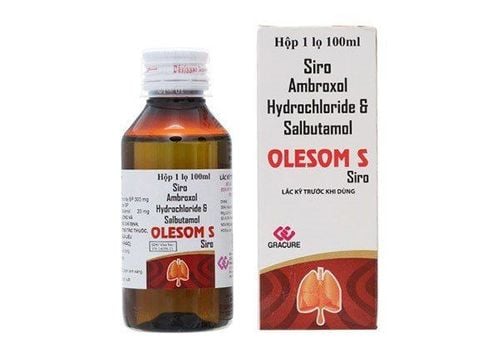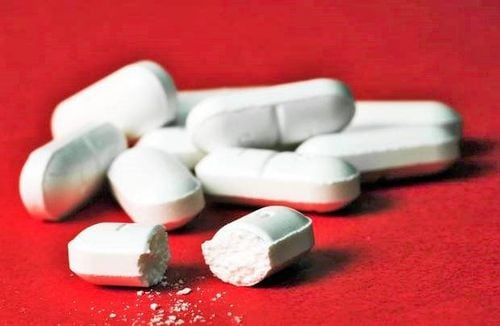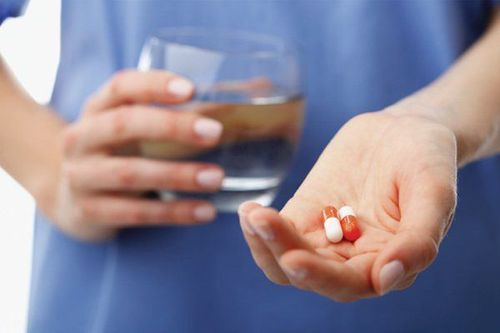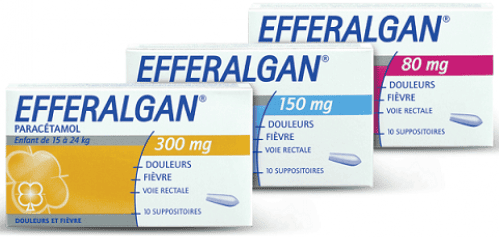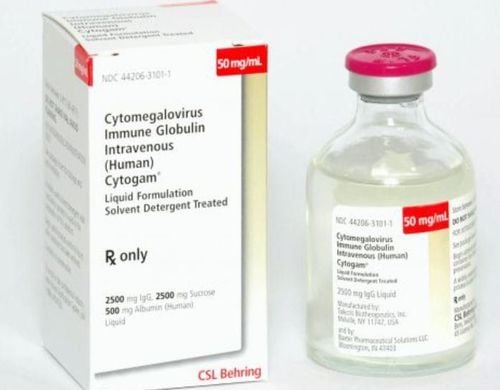This is an automatically translated article.
The drug Lodextrin is an anti-allergic drug and used in cases of hypersensitivity with the ingredient Paracetamol 500mg; Loratadine 5mg; Dextromethorphan hydrobromide 15mg. To better understand what is Lodextrin drug? What is Lodextrin used for? What are the harmful interactions of Lodextrin? What is the correct way to drink? What are the points to pay attention to when using? The following article will help you better understand the drug Lodextrin.1. What is Lodextrin?
Lodextrin has the main ingredient Paracetamol 500mg; Loratadine 5mg; Dextromethorphan hydrobromide 15mg. Belonging to the group of anti-allergic drugs and used in cases of hypersensitivity, the drug is prepared in the form of film-coated tablets manufactured by Agimexpharm Pharmaceutical Joint Stock Company.Lodextrin is prescribed by doctors in the following cases:
Quickly relieve pain symptoms, reduce fever when having a cold, chills, body aches, cough, runny nose. Treatment of flu symptoms: Cough, fever, headache, muscle or joint pain, watery eyes, itchy eyes, stuffy nose, runny nose, sinusitis, seasonal runny nose, allergic rhinitis irritation, itching.
2. What does Lodextrin do?
2.1. Pharmacokinetics
Lodextrin is a pain reliever, antipyretic, antihistamine and cough suppressant, used to treat symptoms of colds, sore throats, and coughs. The drug is combined by the following three active ingredients:Paracetamol has analgesic, antipyretic effects, the drug acts on the thermoregulatory center in the hypothalamus causing hypothermia, increased heat release due to vasodilation and increased peripheral blood flow. record. The drug lowers body temperature in people with fever, but rarely in normal people. Paracetamol relieves pain by raising the pain threshold. With therapeutic doses, the drug has little impact on the cardiovascular and respiratory systems, does not change the acid-base balance, does not cause irritation, scratches or stomach bleeding, does not affect platelets or time bleeding time. Loratadine is a long-acting third-line antihistamine. It is a selective peripheral H1-receptor antagonist and has no CNS depressant effects. Loratadine is effective in alleviating symptoms of allergic rhinitis caused by the release of histamine. Loratadine belongs to a class of second-generation H1-receptor antagonists. Compared with first-generation antihistamines, Loratadine does not cross the blood-brain barrier, so it does not cause drowsiness. Dextromethorphan is a cough suppressant that acts on the cough center in the medulla oblongata. Dextromethorphan is used for the temporary relief of coughs caused by mild irritation of the bronchi and throat such as the common cold or inhalation of irritants. Dextromethorphan is most effective in the treatment of chronic cough, cough without phlegm. The combination of these three ingredients in the drug Lodextrin rapidly relieves symptoms that often appear when having a cold or sore throat, sinusitis (fever, headache, stuffy nose, cough), rhinitis.
2.2. Pharmacodynamic
Regarding the composition Paracetamol Absorption: Paracetamol is rapidly and almost completely absorbed from the gastrointestinal tract. Food can slow the partial absorption of paracetamol extended-release tablets and carbohydrate-rich foods decrease the absorption rate of paracetamol. Peak plasma concentrations are reached within 30 to 60 minutes after oral administration of a therapeutic dose. Distribution: Paracetamol is rapidly and uniformly distributed in most body tissues. Approximately 25% of paracetamol in the blood is bound to plasma proteins. Metabolism: Paracetamol is metabolised in cytochrome P450 in the liver to form N - acetyl benzoquinonimin as an intermediate, which continues to conjugate with the sulfhydryl group of glutathione to produce an inactive substance. Elimination: The drug is excreted in the urine mainly as metabolites, with a clearance of 19.3 l/h. The half-life is about 2.5 hours. When taking high doses of paracetamol (> 10g/day), it will generate a lot of N - acetyl benzoquinonimin which depletes liver glutathione, then N - acetyl benzoquinonimin will react with the sulpyrid group of liver proteins causing liver damage, liver necrosis, can be fatal if not treated promptly. Regarding the composition of Loratadine Absorption: Loratadine is rapidly absorbed after oral administration. Peak plasma concentrations of Loratadine and its active metabolite (descarboethoxyloratadine) are 1.5 and 3.7 hours, respectively. Distribution: 97% of the drug is bound to plasma proteins. The volume of distribution of the drug is 80-120 L/Kg. Metabolism: Loratadine undergoes extensive first-pass metabolism by the cytochrome P450 microsomal enzyme system, mainly to descarboethoxyloratadine, a pharmacologically active metabolite. Elimination: Approximately 80% of the total dose of loratadine is excreted in the urine and faeces equally as metabolites within 10 days. Regarding the composition of Dextromethorphan Absorption: after oral administration, Dextromethorphan is rapidly absorbed and from the gastrointestinal tract. Dextromethorphan peak plasma concentrations within 2 to 2.5 hours. Distribution: Dextromethorphan is absorbed into the bloodstream and crosses the blood-brain barrier into the CSF about 30 to 80%. The antitussive action of dual dextromethorphan is 5 to 6 hours long, and the plasma half-life is 2 to 4 hours. Metabolism: Dextromethorphan is rapidly metabolised by the liver and O - demethylated to give the active metabolite dextrorphan. Dextromethorphan is then N - demethylated and partially conjugated with glucuronic acid and sulfate ions. Elimination: Dextromethorphan is eliminated by the kidneys as unchanged drug or as a demethyl metabolite.2.3. Contraindications of Lodextrin
Patients who are allergic to any ingredient or excipients of Lodextrin. Cough in patients with respiratory failure, asthma, glaucoma, bladder neck obstruction, prostate enlargement. The patient is taking an MAOI (antidepressant). Children under 12 years old.2.4. Lodextrin side effects
Some of the undesirable effects thought to be possible with Lodextrin use include:Related to paracetamol:
Undesirable effects of paracetamol are rare but allergic reactions including skin rash may occur. . Serious skin reactions such as Stevens-Johnson syndrome, Lyell's syndrome, toxic epidermal necrolysis, and acute generalized pustulosis are rare, but potentially fatal. If rash or other skin manifestations appear, discontinue use and consult a physician. Skin rashes and other allergic reactions occur occasionally. Usually erythema or urticaria, but sometimes more severe and may be accompanied by drug fever and mucosal lesions. If fever, blisters around natural cavities, should be considered Stevens-Johnson syndrome, must stop the drug immediately. Overdose of paracetamol can lead to severe liver damage and sometimes acute tubular necrosis. Blood disorders including thrombocytopenia, neutropenia, pancytopenia, leukopenia and agranulocytosis have been reported but not necessarily a causal relationship related to paracetamol. Related to dextromethorphan:
Common Body as a whole: Fatigue, dizziness. Circulatory: Tachycardia. Gastrointestinal: Nausea. Skin: Flushed. Uncommon: Skin: Urticaria. Rare: Occasional mild drowsiness, gastrointestinal disturbances. Inform patients of drugs that may cause drowsiness, and avoid concomitant use of CNS depressants and alcohol. With regard to loratadine:
Ventricular arrhythmias have occurred with some 2nd generation H1 antihistamines. That did not occur with loratadine treatment. When loratadine is used in doses greater than 10mg daily, the following side effects may occur: Common Neurologic: Headache. Digestion: Dry mouth. Uncommon Immune system disorders: Hypersensitivity reactions (including angioedema and anaphylaxis). Nervous: Dizziness. Respiratory: Dry nose and sneezing. Other: Conjunctivitis. Rare Neurological: Depression, convulsions. Cardiovascular: Tachycardia, supraventricular tachycardia, palpitations. Gastrointestinal: Nausea, gastritis. Skin and subcutaneous tissue disorders: Skin rash, alopecia, urticaria. Metabolism: Abnormal liver function, irregular menstruation. Other: Tired. Stop using the drug and inform the doctor about any unwanted effects encountered while using the drug.
2.5. Drug interactions
Related to paracetamol:Long-term intake of high doses of paracetamol slightly increases the anticoagulant effect of coumarin and indandion derivatives. Attention should be paid to the potential for severe hypothermia in patients receiving concomitant phenothiazines and antipyretic therapy. Excessive and long-term alcohol consumption can increase the risk that paracetamol will cause liver toxicity. Anticonvulsants (including phenytoin, barbiturates, carbamazepine) induce enzymes in the liver microsomes, which may increase the hepatotoxicity of paracetamol by increasing the metabolism of the drug into substances that are toxic to the liver. In addition, concomitant use of isoniazid with paracetamol may also lead to an increased risk of hepatotoxicity, but the exact mechanism of this interaction has not been determined. Cholestyramine: Reduces the rate of absorption of paracetamol. Therefore, cholestyramine should not be taken within one hour of taking paracetamol if maximum pain relief is required. Metoclopramide and domperidone: Accelerate the absorption of paracetamol. However, there is no need to avoid concurrent use. Chloramphenicol: Plasma concentrations of chloramphenicol are increased with concomitant use of paracetamol. Do not take with other medicines containing paracetamol. With regard to loratadine:
Possible potential interaction with all known CYP2D6 or CYP3A4 inhibitors when co-administered, resulting in elevated loratadine concentrations, possibly causing an increase in effects unintentional. Metabolism of Loratadine is carried out by cytochrome P450 isoenzymes CYP2D6 and CYP3A4, so concomitant use of drugs that are metabolised or inhibited by these enzymes may result in changes in plasma concentrations of the patient and may have undesirable effects. Drugs that inhibit these enzymes include: erythromycin, cimetidine, quinidine, ketoconazole, fluconazole, and fluoxetin. Concomitant treatment with cimetidine and loratadine resulted in a 60% increase in loratadine plasma concentrations, because cimetidine inhibits the metabolism of loratadine. This has no clinical signs. Concomitant treatment with ketoconazole and loratadine resulted in a 3-fold increase in loratadine plasma concentrations due to inhibition of CYP3A4. There are no clinical signs because loratadine has a wide therapeutic index. Concomitant treatment with erythromycin and loratadine resulted in an increase in loratadine plasma concentrations of loratadine (area under the dosing time curve) of loratadine, up to a mean of 40%, and a mean increase in desloratadine AUC of 46 % compared with loratadine alone. On the electrocardiogram there was no change in the QTc interval. Clinically, no change in the safety of loratadine was observed and there were no reports of sedation or syncope during co-administration of the two drugs. Concomitant administration of loratadine and pseudoephedrine is contraindicated when MAO inhibitors are or have been used within 10 days because these drugs may affect the blood pressure effects of pseudoephedrine. In relation to dextromethorphan:
Do not use dextromethorphan if you are taking monoamine oxidase inhibitors (MAOIs), selective serotonin reuptake inhibitors (SSRIs), or other medications for depression, psychiatric or emotional disorders exposure, or Parkinson's disease, or within 2 weeks of stopping the drug. If you are not sure if your prescription contains one of these medicines, ask your doctor or pharmacist before taking this product.
CYP2D6 Inhibitors: Dextromethorphan is metabolised by CYP2D6 and undergoes extensive first-pass metabolism in the liver. Concomitant use of inhibitors of the enzyme CYP2D6 may increase the body concentration of dextromethorphan to several times higher than normal. This increases the risk of dextromethorphan toxicity for the patient (agitation, confusion, tremor, insomnia, diarrhea, and respiratory distress) and serotonin syndrome. Strong inhibitors of the CYP2D6 enzyme include fluoxetine, paroxetine, quinidine, and terbinafine. When co-administered with quinidine, the plasma concentration of dextromethorphan is increased 20-fold, increasing the CNS adverse effects of this substance. Amiodarone, flecainide and propafenone, sertraline, bupropion, methadone, cinacalcet, haloperidol, perphenazine and thioridazine have similar effects on the metabolism of dextromethorphan. If concomitant use of CYP2D6 inhibitors and dextromethorphan is required, the patient should be monitored and the dose of dextromethorphan may need to be reduced. Concomitant use with CNS depressants may enhance the CNS depressant effects of this drug or of dextromethorphan. Valdecoxib increases the serum concentration of dextromethorphan when taken together. Dextromethorphan used with linezolid causes a syndrome resembling serotonin syndrome. Memantine may increase both the frequency and unwanted effects of memantine and dextromethorphan, so the combination should be avoided. Do not use in combination with moclobemide
2.6. Precautions while using Lodextrin
Use in pregnant women and nursing mothersPregnant women: Paracetamol and Loratadine have no adverse effects on the fetus at the recommended doses for pregnant women. There are no data on the use of Dextromethorphan in pregnant women. Use with caution during pregnancy, use only when clearly needed. Lactation: Paracetamol, Loratadine are excreted in breast milk but are of no clinical significance. There are no data on whether Dextromethorphan and its metabolites are excreted in human milk. Therefore, it should not be used by women who are breastfeeding. People who drive and operate machinery
Side effects dizziness, drowsiness affect the ability to drive and use machines. Be careful in this case. Other special note
Paracetamol: Should not be combined with other drugs containing Paracetamol to avoid overdose or drug poisoning. When symptoms persist for more than 5 days or fever persists for more than 3 days, consult a doctor. With caution in liver and kidney disease, in cirrhotic patients there is a higher risk of overdose. Warning some serious skin reactions but rarely occur Steven-Johnson syndrome, toxic skin necrosis, Lyell syndrome, acute generalized exanthematous pustulosis. Loratadine: Liver failure. Discontinue use 48 hours before performing skin tests for allergies because it may interfere with the results of positive test reactions. Dextromethorphan hydrobromide, caution in the following people: Cough with excessive phlegm, chronic cough in smokers, asthma or emphysema. At risk or experiencing respiratory failure. Are taking drugs that inhibit the enzyme CYP2D6. Dextromethorphan Patients cough with a lot of phlegm in smokers, asthma, bronchiectasis. The patient is at risk of respiratory failure. Use with caution in children with allergies. Do not take the drug for more than 7 days in adults and 5 days in children. If symptoms do not improve, contact your physician.
3. How to use Lodextrin effectively
3.1. How to use
The drug is administered orally directly with filtered water. Use medication as prescribed by a qualified doctor3.2. Dosage
Adults and children over 12 years: Take 1 tablet x 2 times a day. Patients with liver or kidney failure: Take 1 tablet per day, can be divided into 2 times or taken every other day. Doses should be taken 6 to 8 hours apart.3.3. Overdose
Related to paracetamol: Lodextrin overdose may experience nausea, vomiting, abdominal pain, drowsiness, tachycardia, blurred vision, nystagmus, urinary retention, numbness, hallucinations, ataxia, respiratory failure, convulsions, the most dangerous is liver failure or hepatocellular necrosis caused by paracetamol. Related to dextromethorphan: Nausea, vomiting, somnolence, blurred vision, nystagmus, urinary retention, coma, hallucinations, ataxia, respiratory depression, convulsions (common in children) ). Related to loratadine: In adults, when taking an overdose of loratadine tablets (40 - 180mg), there are manifestations: Drowsiness, tachycardia, headache. In children, there are extrapyramidal manifestations and palpitations, when the syrup is overdosed (in excess of 10 mg). Treatment: There is no specific treatment for Lodextrin overdose. Appropriate treatment is symptomatic when overdose is suspected Reference source: ungthutap.comPlease dial HOTLINE for more information or register for an appointment HERE. Download MyVinmec app to make appointments faster and to manage your bookings easily.




